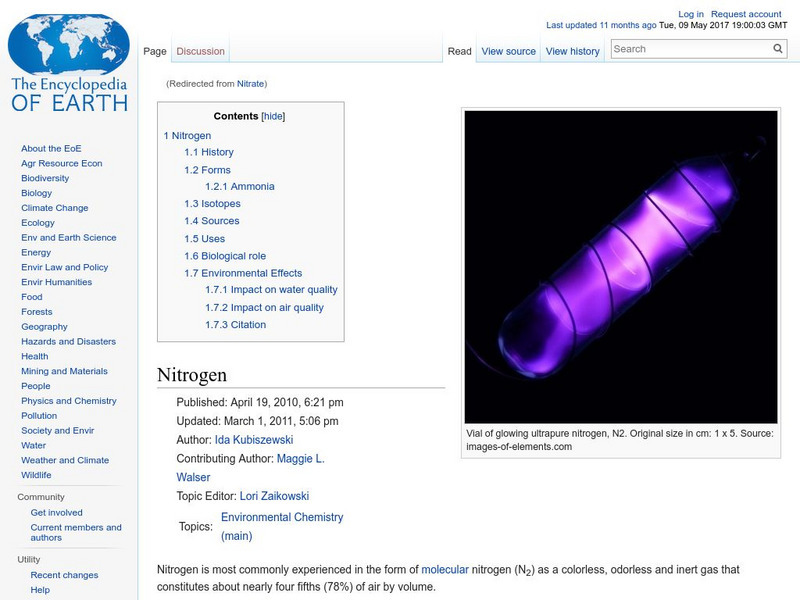Curated OER
Landfill Lounge
Students accurately construct a model of a sanitary landfill and identify the parts of the landfill and explain their function. They work in grous using a clear plastic box, modeling clay, soil and a variety of garbage to create their...
Curated OER
Making Paper
Fourth graders investigate the paper usage in their classroom and in other countries by using estimation, counting, and measurement skills. They make paper from recycled paper.
Curated OER
Eco-Logical: A Coastal Logic Problem
Fourth graders study the characteristics of five coastal communities. They use logic cards and matching activities to identify the proper community for plant and animal species.
Curated OER
Ozone Pollution: Smog Alert
Students simulate the development of smog. They discover how it forms naturally in nature. They read news articles about the ozone and pollution. They discuss what they can do to lower the pollution they generate.
Curated OER
Survival
Students identify characteristics of Australia, Africa and Antarctica and compare and contrast them to each other. They work together to identify adaptations that animals have used to survive. They also practice classifying animals.
Curated OER
Lights Out!
Students examine static and current electricity, and discuss what their lives would be like without electricity. They listen to a teacher-led lecture about electrons and atoms, and explore static electricity using a comb or a balloon...
Curated OER
Grand Celebration! Broadside
Students research the construction and history of the Erie Canal. They answer discussion questions in small groups, draw and label the Erie Canal on a map of New York State, read and discuss a handout, and complete a worksheet.
Curated OER
Groundwater: Cleaning Up
Pupils research the various aspects of groundwater contamination that threaten health and human safety. They create a model and display that informs other about the health and safety risks. Students illustrate ways in which these...
Curated OER
Plants and Air Purity
Learners explore how green plants help improve air quality. They read an article and discuss the importance of air quality and its effects on the human body. They investigate by connecting hose to the top of a Bell jar and to a funnel....
Curated OER
Coal and the Environment
Students read about how burning coal affects the environment. After students finish reading about how burning coal affects the environment they have a group discussion to discuss what they thought about the information.
Curated OER
Yearly Place Based theme
Students are awaken to their surroundings. They gain a greater access of how their city was formed. Students assess the human impact on the land. They comprehend the cultural diversity of the city.
Curated OER
Geography: Islands and Alcatraz
Students, in groups, create maps of islands including map keys and compass roses. They compare and contrast their island communities with that of the island prison, Alcatraz. Students select from a series of projects, including writing...
Curated OER
How Big is a Crowd?
Sixth graders compare the relative sizes of the five Great Lakes and their human populations. They describe some of the problems that arise when many people depend on a limited resoure. Students discuss how the Great Lakes and the...
Curated OER
Is It Lunar or Lunacy?
Sixth graders are introduced to the moon and its phases. Individually, they draw a sketch of each phase of the moon and read a short article about Galileo. To end the lesson, they examine the difference between refracting and...
Curated OER
Settling Nroth America: Improvisation and Playwriting
Middle schoolers map the classroom by marking the movement of the first Americans' migration from Alaska down into North America. To improve their skills in map-reading and sense of direction, students identify physical features of the...
Curated OER
Caterpillar Habit
Students watch a caterpillar change and become a butterfly. In this lesson about the life cycle of a caterpillar and a butterfly, students prepare and maintain the habitat of the caterpillar. Students observe the stages of the...
Curated OER
Cell Community
Seventh graders use technology to review cell structure and function. In this cells less, 7th graders review the parts and functions of a cell, and use photography/video and PowerPoint to enhance their explorations.
Curated OER
From Slavechild to Freedom
Third graders read excerpts from 5 slave narratives and study and compare/contrast their families, living conditions, duties, methods of escape and destinations. In this history lesson, 3rd graders get into small groups to present their...
Utah Education Network
Uen: Water World Story
Fourth graders will write a story about how a drop of water may have traveled to arrive at the school.
Utah Education Network
Uen: Water Pollution Graphing: Bugs Don't Bug Me
Activity shows the link between land use activities within a watershed and water quality.
US Environmental Protection Agency
Epa: Reservoirs: Holding Tanks for Drinking Water [Pdf]
How do people get their water reservoirs for drinking water? This site features an in-depth explanation of this question. Come and check it out.
US Department of Energy
U.s. Department of Energy: Water Power Program: Types of Hydropower Plants
Learn about the three types of hydroelectric power plants used to capture the energy from water at a hydropower dam site.
Encyclopedia of Earth
Encyclopedia of Earth: Physics & Chemistry: Nitrate
Discusses the chemistry of nitrate, the negative agricultural effects of too much nitrate in soil and in water sources, its toxicity to plants and livestock, and the impact on human health.
Other
Dupont: Make Your Own Water Turbine
Students will create their own water turbine to demonstrate the use of water as a renewable energy source. Included is a detailed lesson plan, a video of the activity, and assessment questions.





















![Epa: Reservoirs: Holding Tanks for Drinking Water [Pdf] Activity Epa: Reservoirs: Holding Tanks for Drinking Water [Pdf] Activity](https://content.lessonplanet.com/knovation/original/784767-be34c4aa4535a4640e6dc98eb70b3542.jpg?1661270399)

